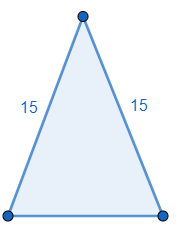
How to find the third side of an isosceles triangle? I have the length of the two other legs, which are both
Answer
467.1k+ views
1 likes
Hint: Problems of this type have non-specific answers, this means that we will be able to find the range between which the answer lies. Using a trigonometric formula of isosceles triangle, we will get the limits between which the length of the third side of an isosceles triangle can exist. So, we can take any value between the limits and conclude it as the answer to the problem.
Complete step by step answer:

For an isosceles triangle if the given two sides have the same length then for calculating the length of the third side of the triangle, we can use a trigonometric formula for finding the length of the unknown side of the triangle, which is
Here,
The angle
We know that
From the formula we get
Also,
As the angle
Therefore, we can conclude that the third side of an isosceles triangle can be of any length between
Note:
The problem can also be solved by applying the property of triangles. According to a property of triangles the sum of any two sides is greater than the third and the difference between any two sides is less than the third. So, in this case the lower limit for the length of the third side is
Complete step by step answer:

For an isosceles triangle if the given two sides have the same length then for calculating the length of the third side of the triangle, we can use a trigonometric formula for finding the length of the unknown side of the triangle, which is
Here,
The angle
We know that
From the formula we get
Also,
As the angle
Therefore, we can conclude that the third side of an isosceles triangle can be of any length between
Note:
The problem can also be solved by applying the property of triangles. According to a property of triangles the sum of any two sides is greater than the third and the difference between any two sides is less than the third. So, in this case the lower limit for the length of the third side is
Recently Updated Pages
Master Class 12 Economics: Engaging Questions & Answers for Success

Master Class 12 Maths: Engaging Questions & Answers for Success

Master Class 12 Biology: Engaging Questions & Answers for Success

Master Class 12 Physics: Engaging Questions & Answers for Success

Master Class 4 Maths: Engaging Questions & Answers for Success

Master Class 4 English: Engaging Questions & Answers for Success

Trending doubts
Fill the blanks with the suitable prepositions 1 The class 9 english CBSE

Difference Between Plant Cell and Animal Cell

Given that HCF 306 657 9 find the LCM 306 657 class 9 maths CBSE

The highest mountain peak in India is A Kanchenjunga class 9 social science CBSE

What is the difference between Atleast and Atmost in class 9 maths CBSE

What is pollution? How many types of pollution? Define it




